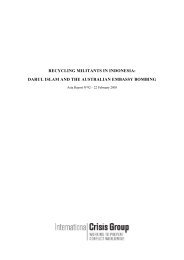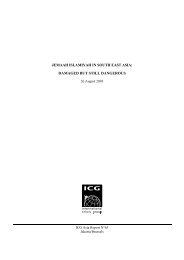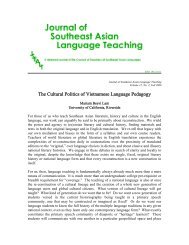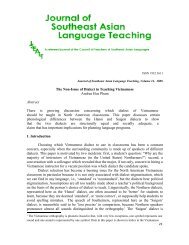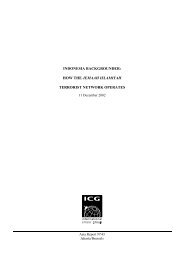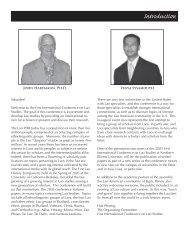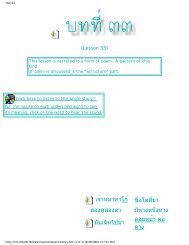Review of Reading and Writing Thai - SEAsite - Northern Illinois ...
Review of Reading and Writing Thai - SEAsite - Northern Illinois ...
Review of Reading and Writing Thai - SEAsite - Northern Illinois ...
Create successful ePaper yourself
Turn your PDF publications into a flip-book with our unique Google optimized e-Paper software.
ISSN 1932-3611<br />
Journal <strong>of</strong> Southeast Asian Language Teaching<br />
Volume 14, 2008<br />
<strong>Reading</strong> <strong>and</strong> <strong>Writing</strong> <strong>Thai</strong> by Somsonge Burusphat. 2006. 320 pages. Bangkok: Institute<br />
<strong>of</strong> Language <strong>and</strong> Culture for Rural Development, Mahidol University. $10/Baht 350.<br />
This is a lucidly <strong>and</strong> elegantly presented learner’s book on the <strong>Thai</strong> system <strong>of</strong> writing.<br />
Published by the renowned historical-comparative <strong>Thai</strong> linguist, Dr. Somsonge<br />
Burusphat, the book is the result <strong>of</strong> teaching <strong>Thai</strong> to undergraduates at Mahidol<br />
University International College in twenty classes for the years 1995-2004. Originally<br />
distributed as h<strong>and</strong>outs, the lessons have been revised based on feedback from students<br />
<strong>and</strong> faculty alike. Knowing that it has been thoroughly field-tested is assurance that it will<br />
work in <strong>Thai</strong> classes elsewhere.<br />
The “Gedney system” for presenting <strong>Thai</strong> spoken tones using his simple chart <strong>of</strong> tone<br />
boxes is both linguistically <strong>and</strong> pedagogically sound <strong>and</strong> is based on the history <strong>of</strong> Tai<br />
languages as well. This is what Ajan Somsonge has done. My own students who have<br />
gone to <strong>Thai</strong>l<strong>and</strong> to continue their studies report back to me that this chart is the single<br />
most useful h<strong>and</strong>out they have in their possession when they encounter written <strong>Thai</strong> on<br />
signs, menus, schedules <strong>and</strong> the like <strong>and</strong> need confirmation on how to produce the correct<br />
tones.<br />
She wisely begins teaching the middle class consonants first for the obvious reason that<br />
they are fewest in number <strong>and</strong> have only two “rare consonants”she deals with these later<br />
in a special chapter (14) that focuses on all the rarely used consonants that would only be<br />
a source <strong>of</strong> frustration to beginning students if presented wholesale at the outset.<br />
Unlike many texts designed to teach foreigners to read <strong>and</strong> write <strong>Thai</strong>, this one places<br />
emphasis on using <strong>Thai</strong> script exclusively at the outset, not IPA. The latter is used for<br />
pronunciation purposes, much like the pronunciation guide in any dictionary, but the<br />
student is never asked to write in transcription, which, to me is both a burden <strong>and</strong> a crutch<br />
that only slows down the task <strong>of</strong> learning to become literate in the language. The text has<br />
many work pages that asks the learner to practice writing the shapes <strong>of</strong> the letters in the
early pages <strong>and</strong> whole words later. But all <strong>of</strong> the writing dem<strong>and</strong>ed <strong>of</strong> the student is<br />
exclusively in <strong>Thai</strong> script.<br />
In the later chapters, the learner is presented with authentic reading selections in the form<br />
<strong>of</strong> menus, signs, songs, t.v. schedule <strong>and</strong> articles. There are many other enjoyable cultural<br />
items that provide valuable insights to <strong>Thai</strong> ways as well. One section lists topics for<br />
short student compositions such as a c.v., short notes, an informal letter. There is an extra<br />
bonus at the end <strong>of</strong> the book that the student who needs a break from formal study can<br />
use to have some fun: an Appendix (p. 313) <strong>of</strong> “One Hundred Fun <strong>and</strong> Easy Things to<br />
Do in Bangkok.” That is probably worth the price <strong>of</strong> the book, which is a bargain at only<br />
$10 U.S.<br />
The book is skillfully designed with alternating lines <strong>of</strong> shading to aid the eye <strong>and</strong> large<br />
font size to reduce the confusion over loops <strong>and</strong> diacritics that st<strong>and</strong> out boldly in<br />
enlarged form. A judicious use <strong>of</strong> photos <strong>and</strong> cartoons adds to the aesthetic pleasure <strong>of</strong><br />
owning <strong>and</strong> using the book. It is compact enough to tuck into the side pocket <strong>of</strong> a<br />
backpack or lunch bag. This is definitely a book that belongs in the book bag or on the<br />
bookshelf <strong>of</strong> every student <strong>and</strong> teacher <strong>of</strong> <strong>Thai</strong>.<br />
<strong>Review</strong>er:<br />
John Hartmann, Pr<strong>of</strong>essor <strong>of</strong> <strong>Thai</strong><br />
<strong>Northern</strong> <strong>Illinois</strong> University






